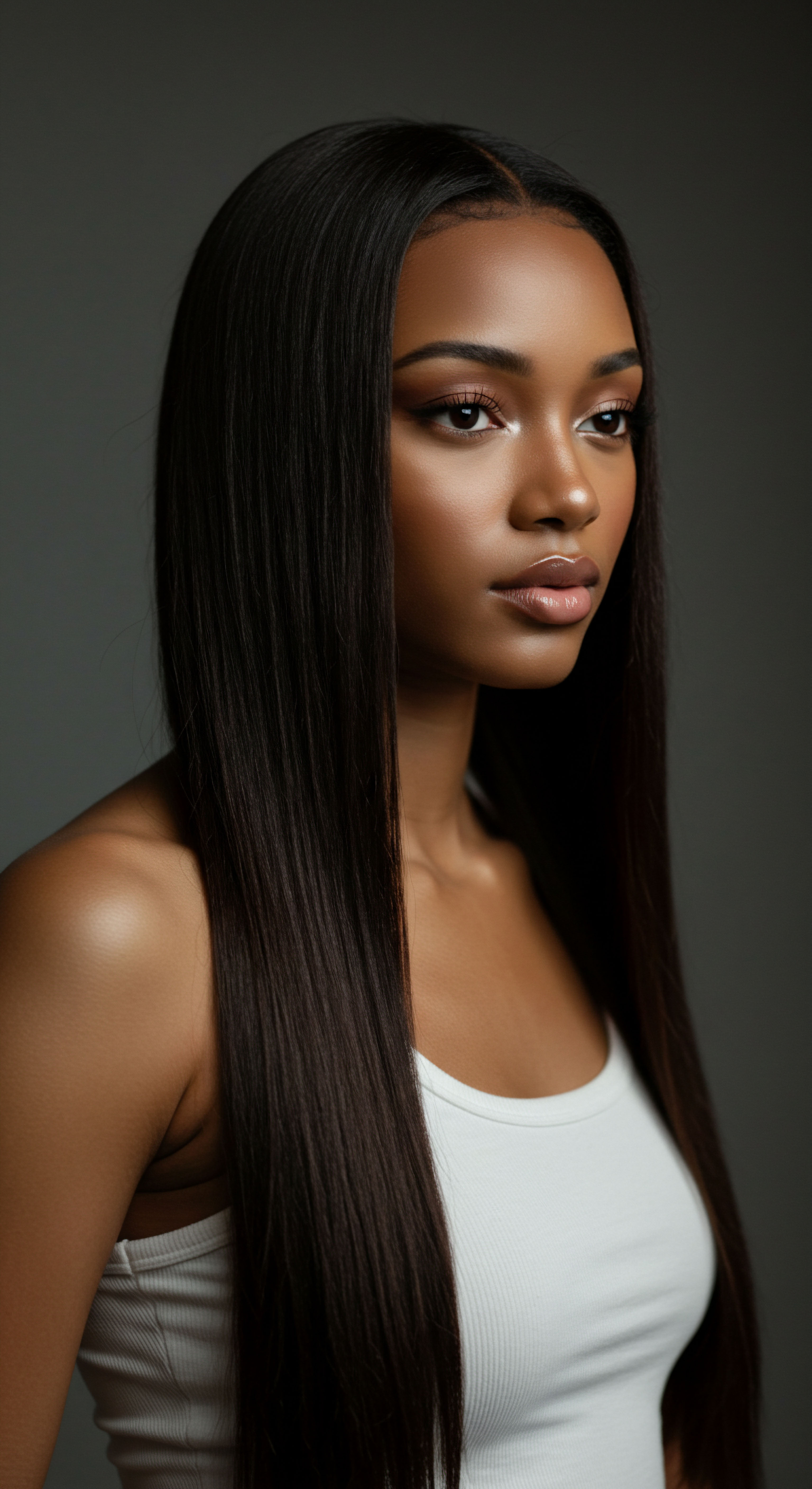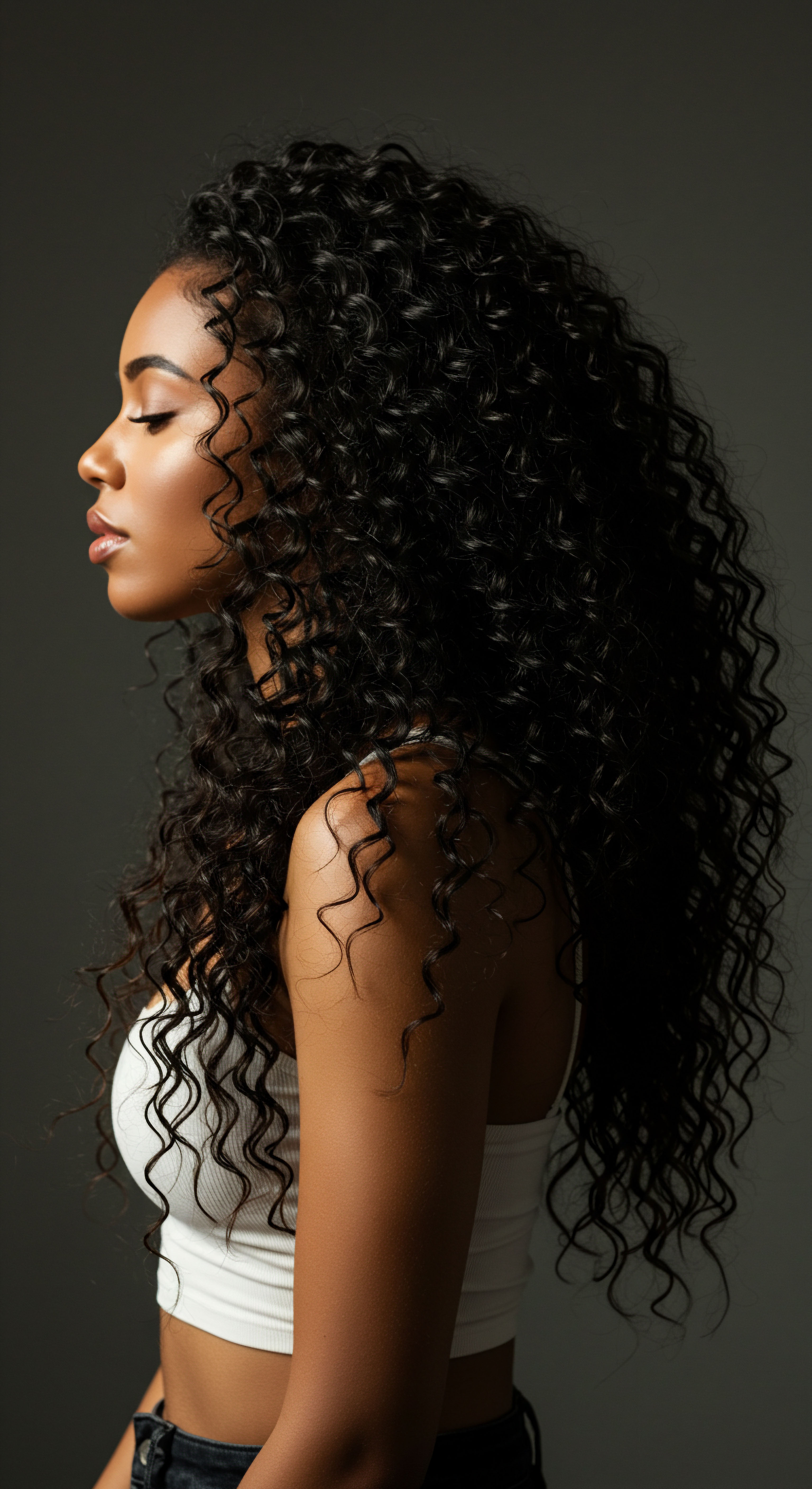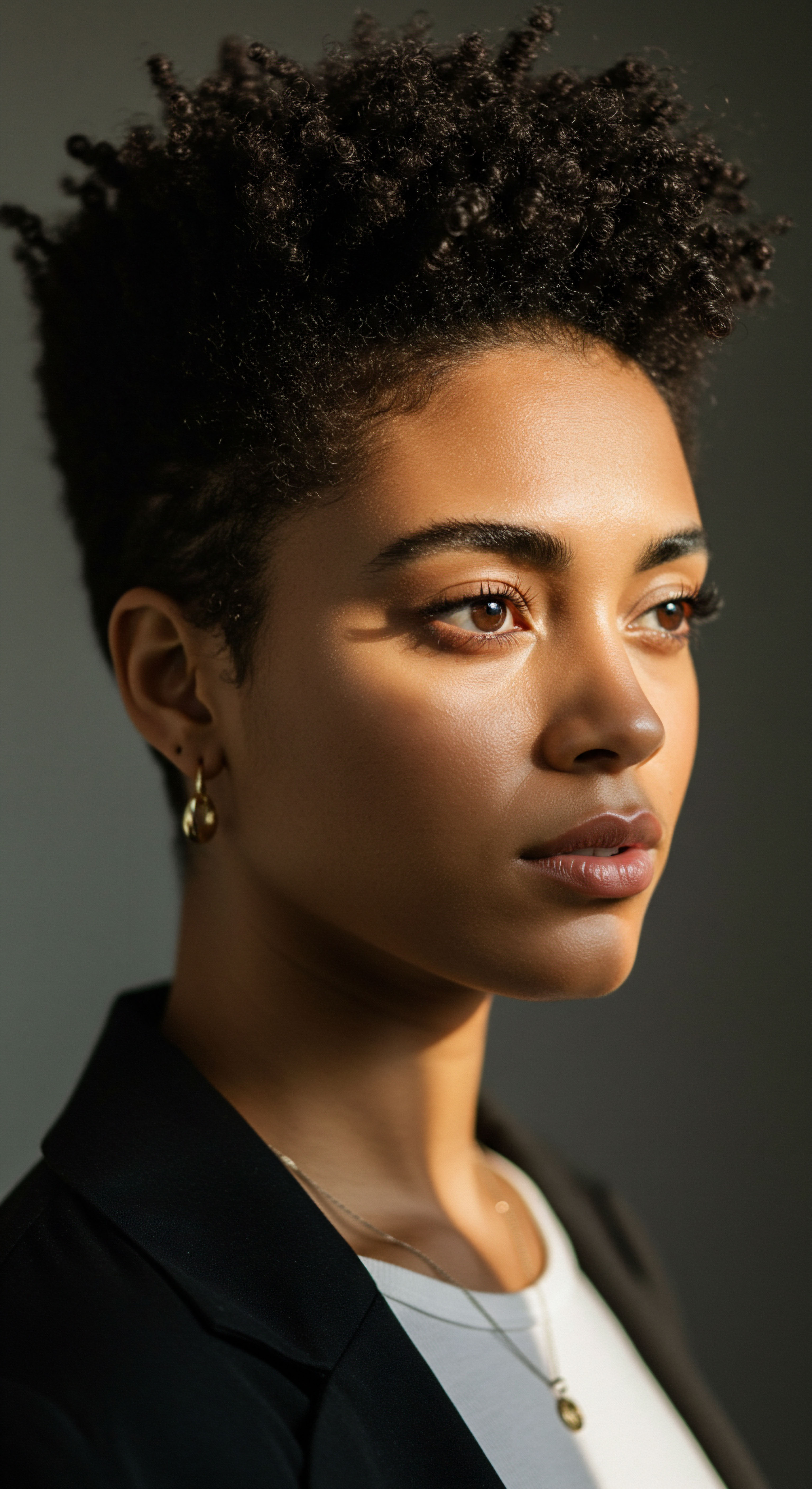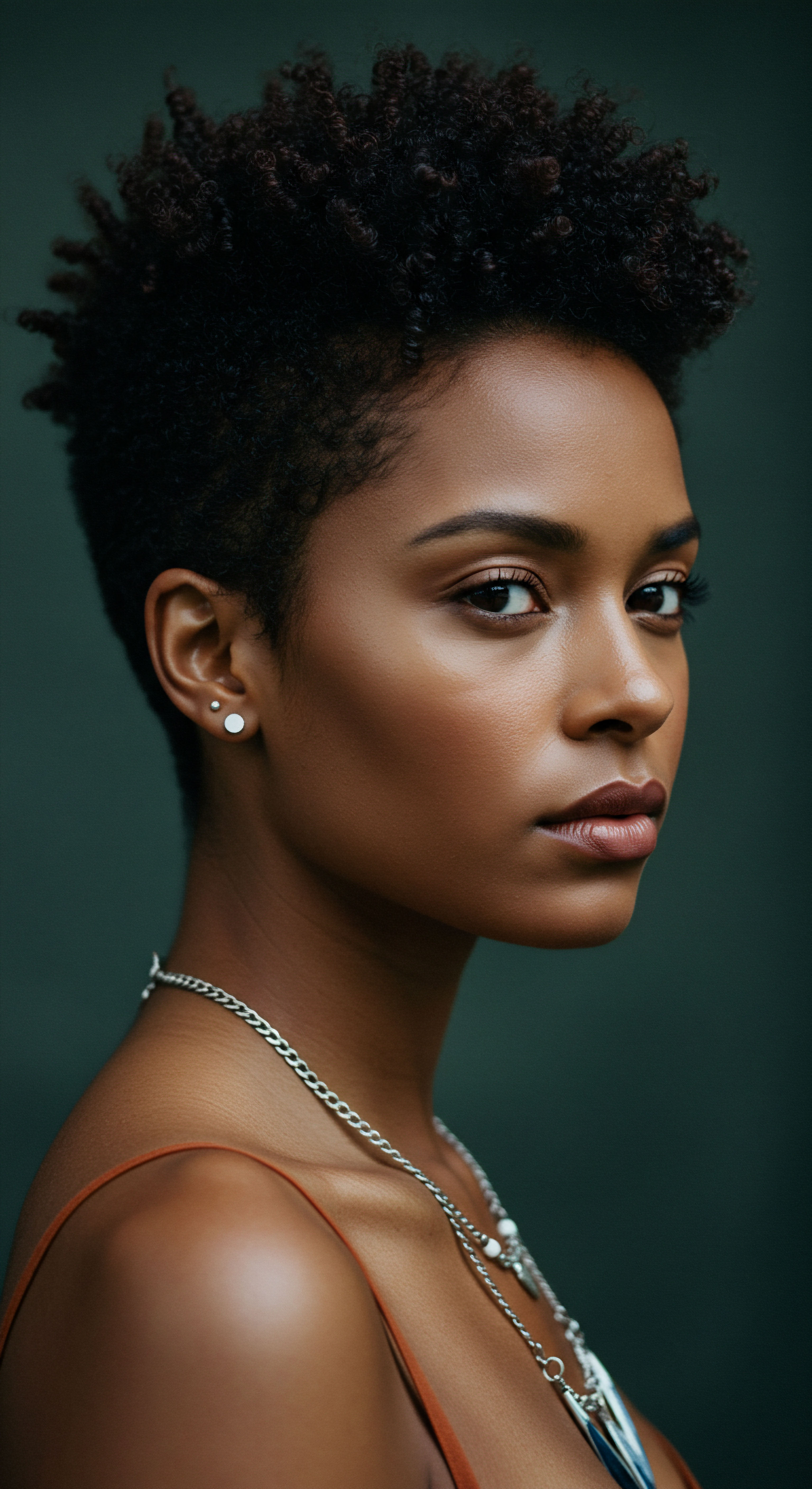
Roots
The story of textured hair, with its coils, curls, and waves, is one of remarkable strength and delicate complexity. Within its very structure lies a wisdom, a testament to resilience, yet it also holds a subtle vulnerability to the unseen forces that shape our daily rituals. Among these forces, the very water we use for cleansing and care plays a quiet, yet profound, role. This exploration begins at the foundational level, seeking to understand how the water’s inherent acidity or alkalinity, its pH, whispers to the hair shaft, particularly concerning the mineral companions it carries.
Consider the hair shaft itself, a marvel of biological engineering. Its outermost layer, the Cuticle, resembles tiny, overlapping scales, much like shingles on a roof. These scales are designed to protect the inner cortex, which grants hair its strength and elasticity. The integrity of these cuticle scales is paramount for healthy, vibrant hair.
When these scales lie flat and smooth, hair reflects light, feels soft, and retains moisture with ease. When they are lifted, perhaps by external influences, the hair can appear dull, feel rough, and become prone to breakage.
Deep within the hair’s structure, a world of chemical interactions constantly takes place. The hair’s surface, particularly the cuticle, carries a slight negative charge. This characteristic influences how it interacts with various substances, including the dissolved minerals present in water. The PH Scale, a measure of hydrogen ion concentration, dictates the acidity or alkalinity of a solution, ranging from 0 (highly acidic) to 14 (highly alkaline), with 7 as neutral.
Our hair and scalp naturally reside on the slightly acidic side, typically around 4.5 to 5.5. This natural acidity helps keep the cuticle scales sealed and the scalp’s protective barrier robust.
The delicate balance of water’s pH directly influences the outermost layer of textured hair, its cuticle, dictating its openness and receptivity to mineral attachment.
When water with a pH significantly different from hair’s natural range comes into contact with the strands, a series of reactions can unfold. Alkaline water, possessing a higher pH, causes the cuticle scales to swell and lift. This opening of the cuticle, while sometimes necessary for cleansing, can also expose the inner hair shaft, making it more susceptible to damage and, crucially, to the deposition of minerals. Conversely, acidic water helps to smooth and close the cuticle, a desirable outcome for many hair care practices.

Understanding Water’s Mineral Content
Water, especially tap water, is rarely pure H₂O. It carries a diverse array of dissolved substances, including various minerals. The concentration of these minerals determines water’s “hardness.” Hard water contains higher concentrations of multivalent metal ions, primarily Calcium and Magnesium.
Other common mineral guests can include iron, copper, and even lead, depending on the water source and plumbing infrastructure. These minerals exist as ions, carrying positive charges.
The presence of these mineral ions in water presents a unique challenge for textured hair. Due to its inherent structure—the twists and turns of coils and curls—textured hair offers more surface area and more opportunities for these ions to settle and accumulate. The raised cuticle scales, particularly when exposed to alkaline water, act as microscopic landing pads, inviting these mineral guests to adhere.

How Does Mineral Adherence Occur?
The binding of minerals to hair is a complex interplay of electrostatic attraction, surface adsorption, and precipitation.
- Electrostatic Attraction ❉ Hair’s negatively charged surface draws in positively charged mineral ions. This attraction becomes stronger as the hair’s surface charge is altered, often by high pH.
- Surface Adsorption ❉ Minerals adhere to the hair’s surface through various chemical bonds, sometimes forming insoluble deposits that resist rinsing.
- Precipitation ❉ In some cases, minerals react with other substances on the hair (like product residues or even components of shampoo) to form insoluble compounds that literally precipitate onto the hair shaft.
The implications of this mineral binding are far-reaching. Accumulated minerals can lead to a host of undesirable outcomes, from a dull appearance and rough texture to impaired moisture absorption and increased brittleness. The very foundation of hair health rests upon a delicate chemical balance, and water pH stands as a significant conductor in this intricate orchestra.

Ritual
Our daily interactions with textured hair are a series of thoughtful rituals, each choice, from cleanser to conditioner, shaping its vitality. Yet, beyond the visible products, a silent influence often goes unnoticed ❉ the pH of the water itself. This section delves into the practical wisdom surrounding water pH and its tangible effects on mineral attachment during our hair care practices. It is a journey into understanding how to work with water, rather than against it, to maintain the vibrancy of textured strands.
When textured hair encounters water, particularly water with a pH outside its natural slightly acidic range, a cascade of events unfolds. Alkaline water, with a pH above 7, causes the hair’s cuticle to lift. While this opening can be helpful for thorough cleansing, allowing dirt and product buildup to be washed away, it simultaneously creates an environment where minerals dissolved in the water can readily deposit onto the hair shaft. These minerals, primarily calcium and magnesium from hard water, along with trace metals like iron and copper, possess positive charges that are drawn to the negatively charged hair surface.

The Unseen Residue
Over time, repeated exposure to mineral-laden water can lead to a significant accumulation of these deposits on the hair. This build-up, often invisible to the naked eye in its early stages, can have a profound impact on the hair’s look and feel. The hair may begin to feel rough, stiff, or appear dull, lacking its natural luster. It can also become more difficult to detangle, leading to increased friction and potential breakage during styling.
Consider the way a clean sponge absorbs water readily. Hair, when free of mineral deposits, behaves similarly, allowing moisture to penetrate the shaft efficiently. When minerals coat the hair, they can create a barrier, hindering the effective absorption of water and conditioning agents.
This leads to hair that feels perpetually dry, despite consistent moisturizing efforts. Conditioners and leave-ins, designed to hydrate and soften, may struggle to perform their intended function because they cannot fully reach the hair’s core.
Consistent use of pH-balanced products and water can minimize mineral buildup, allowing textured hair to retain its natural moisture and vibrancy.

Cleansing with Purpose
The cleansing ritual becomes particularly important when addressing mineral binding. Shampoos formulated to be slightly acidic, or those containing Chelating Agents, play a crucial role. Chelating agents are compounds that bind to metal ions, forming soluble complexes that can then be rinsed away from the hair. Common chelating agents found in hair products include disodium EDTA, tetrasodium EDTA, phytic acid, and citric acid.
A deliberate approach to washing can mitigate the effects of hard water.
- Pre-Poo Treatments ❉ Applying a light oil or conditioner before shampooing can offer a protective layer, reducing the direct impact of hard water on the hair shaft.
- Chelating Shampoos ❉ Incorporate a chelating or clarifying shampoo into your routine periodically, perhaps once a month or every few weeks, depending on water hardness and product use. This helps to lift and remove accumulated mineral deposits.
- Rinse Thoroughly ❉ Ensure all product is rinsed from the hair. Residual product can sometimes interact with minerals, creating further deposits.
Beyond cleansing, the pH of conditioning treatments also plays a role. Conditioners are typically formulated to be acidic, helping to close the cuticle scales that may have been lifted by alkaline water or shampoo. This closing action smooths the hair, seals in moisture, and reduces the likelihood of further mineral adhesion. A final rinse with diluted apple cider vinegar, a natural acidic rinse, is a traditional practice that serves a similar purpose, though it should be used sparingly to avoid excessive drying.
| Product Type Alkaline Shampoos |
| Typical PH Range 7.0 – 9.0+ |
| Hair Impact Cuticle swelling, opens hair shaft |
| Product Type Acidic Shampoos |
| Typical PH Range 5.0 – 6.5 |
| Hair Impact Cleansing with minimal cuticle lift |
| Product Type Conditioners |
| Typical PH Range 3.5 – 5.0 |
| Hair Impact Cuticle closure, smoothing |
| Product Type Leave-in Treatments |
| Typical PH Range 4.0 – 5.5 |
| Hair Impact Moisture retention, cuticle sealing |
| Product Type Maintaining a balanced pH in hair care supports cuticle integrity and reduces mineral buildup. |
The deliberate choice of products and understanding their pH implications empowers us to curate a hair care ritual that truly serves textured strands, safeguarding them from the subtle, yet pervasive, influence of water’s mineral load.

Relay
Moving beyond the foundational and the practical, we turn our gaze to the deeper interplay of water pH, mineral binding, and the intricate biology of textured hair. This exploration unearths the less obvious consequences of these interactions, drawing from scientific observations and revealing the profound, sometimes silent, challenges that water quality presents to the integrity and health of coiled and curly strands. We aim to understand not just what happens, but the underlying mechanisms and their far-reaching implications.
The hair shaft, a complex biomaterial, possesses an intrinsic ability to interact with its environment. When water, particularly hard water, is introduced, the minerals within it—calcium, magnesium, iron, copper—do not simply sit on the surface. Their adherence is influenced by the surrounding pH, a factor that dictates the hair’s surface charge and the solubility of the mineral ions themselves.
A higher pH, characteristic of alkaline water, increases the negative charge density on the hair’s surface, making it a more attractive site for positively charged metal ions. This heightened attraction facilitates stronger, more persistent binding.

The Impact of Iron and Copper on Hair
While calcium and magnesium are widely recognized hard water culprits, the presence of trace metals like iron and copper, often from corroding pipes or natural water sources, poses a distinct and more insidious threat to textured hair. These metals, even in minute quantities, are not merely cosmetic nuisances; they are catalytic agents for oxidative damage.
Research indicates that Iron, when bound to the hair shaft, can significantly accelerate the degradation of hair proteins, particularly keratin, through a process known as the Fenton reaction. This reaction generates highly reactive free radicals, which attack the hair’s disulfide bonds—the very linkages that give hair its strength and shape. The rate of this oxidative damage is often exacerbated in an alkaline environment, where iron’s binding affinity to hair increases.
A study published in the International Journal of Cosmetic Science in 2004 demonstrated that hair treated with iron salts at higher pH levels exhibited a greater reduction in tensile strength and increased susceptibility to breakage compared to hair treated at lower pH, indicating more severe oxidative degradation. This suggests that even small amounts of iron, when coupled with high pH water, can inflict disproportionate harm on the delicate protein matrix of textured hair.
Trace metals like iron and copper, especially in alkaline conditions, can initiate destructive oxidative processes within the hair shaft, weakening its structure.
Similarly, Copper can also catalyze oxidative processes, leading to issues such as unwanted discoloration, particularly in lighter hair colors, but also contributing to the overall weakening of hair structure in textured strands. The binding of copper to hair is also pH-dependent, with increased adsorption observed at higher pH values. This cumulative damage from iron and copper contributes to hair feeling brittle, appearing dull, and becoming more challenging to manage.

Chelation Beyond Cosmetic Appeal
The scientific understanding of mineral binding underscores the importance of chelating agents. These compounds, with their specific molecular structures, act as molecular “claws,” enveloping metal ions and preventing them from reacting with the hair or precipitating onto its surface. Their inclusion in shampoos and treatments is not simply for cosmetic shine; it is a critical strategy for preserving the structural integrity of the hair fiber.
The effectiveness of chelating agents is also influenced by pH. Some chelants perform optimally within specific pH ranges, highlighting the need for carefully formulated hair care products. For instance, EDTA, a common chelating agent, functions well across a broad pH range, making it a versatile choice for removing a variety of metal ions. Citric acid, another natural chelator, is most effective in acidic conditions, aligning with the hair’s natural pH.
| Metal Ion Calcium (Ca²⁺) |
| Primary Source Hard water |
| Adsorption Tendency at High PH High |
| Potential Hair Impact Stiffness, dullness, reduced moisture absorption |
| Metal Ion Magnesium (Mg²⁺) |
| Primary Source Hard water |
| Adsorption Tendency at High PH High |
| Potential Hair Impact Rough texture, product build-up |
| Metal Ion Iron (Fe²⁺/Fe³⁺) |
| Primary Source Pipes, natural water |
| Adsorption Tendency at High PH Increased |
| Potential Hair Impact Oxidative damage, breakage, discoloration |
| Metal Ion Copper (Cu²⁺) |
| Primary Source Pipes, natural water |
| Adsorption Tendency at High PH Increased |
| Potential Hair Impact Discoloration, oxidative damage |
| Metal Ion Alkaline water enhances the binding of these ions, leading to cumulative hair damage. |
Beyond the chemical reactions, the cumulative effect of mineral buildup has a particular resonance for textured hair. The unique coil patterns of curly and coily hair create natural traps for these deposits, making them harder to rinse away compared to straighter hair types. This structural predisposition means textured hair can accumulate higher concentrations of minerals over time, leading to more pronounced issues with dryness, brittleness, and breakage.

Can PH-Adjusted Water Prevent Damage?
The idea of adjusting water pH for hair care has gained traction, moving from anecdotal wisdom to scientifically supported practice. Shower filters designed to reduce mineral content or alter pH offer one avenue. For those without such filters, simple acidic rinses, carefully diluted, serve a similar purpose by restoring the hair’s natural pH and sealing the cuticle. The goal is to minimize the time hair spends in an alkaline state, thereby limiting the window for mineral binding and the subsequent cascade of structural degradation.
The nuanced understanding of water pH and mineral binding allows for a more informed and preventative approach to textured hair care. It shifts the focus from merely treating symptoms to addressing the root causes of hair distress, empowering individuals to create environments where their hair can truly flourish. This knowledge, deeply rooted in science, informs a gentle, yet powerful, ritual of preservation for textured strands.

Reflection
The journey through the intricate world of water pH and mineral binding to textured hair reveals a delicate dance between environmental elements and biological resilience. It reminds us that even the most seemingly benign aspects of our daily routines, like the water we use, hold profound sway over the health and vitality of our strands. This exploration underscores the importance of mindful engagement with our hair, understanding its inherent needs, and providing it with the precise conditions to thrive. The wisdom lies not in rigid rules, but in an informed awareness that guides our choices, allowing textured hair to tell its full, vibrant story.

References
- Marsh, J.M. et al. “The Effect of Metal Ions on the Oxidation of Hair.” International Journal of Cosmetic Science, vol. 26, no. 5, 2004, pp. 245-253.
- Robbins, C.R. Chemical and Physical Behavior of Human Hair. 5th ed. Springer, 2012.
- Barel, A.O. et al. Handbook of Cosmetic Science and Technology. 4th ed. CRC Press, 2014.
- Sakamoto, K. et al. Cosmetic Science and Technology ❉ Theoretical Principles and Applications. Elsevier, 2017.
- Trueb, R.M. The Difficult Hair. Springer, 2018.
- Wilkerson, M. The Science of Black Hair ❉ A Comprehensive Guide to Textured Hair. CreateSpace Independent Publishing Platform, 2013.
- Gammon, L. The Hair Care Revolution ❉ A Practical Guide to Understanding Your Hair and Products. Self-published, 2020.